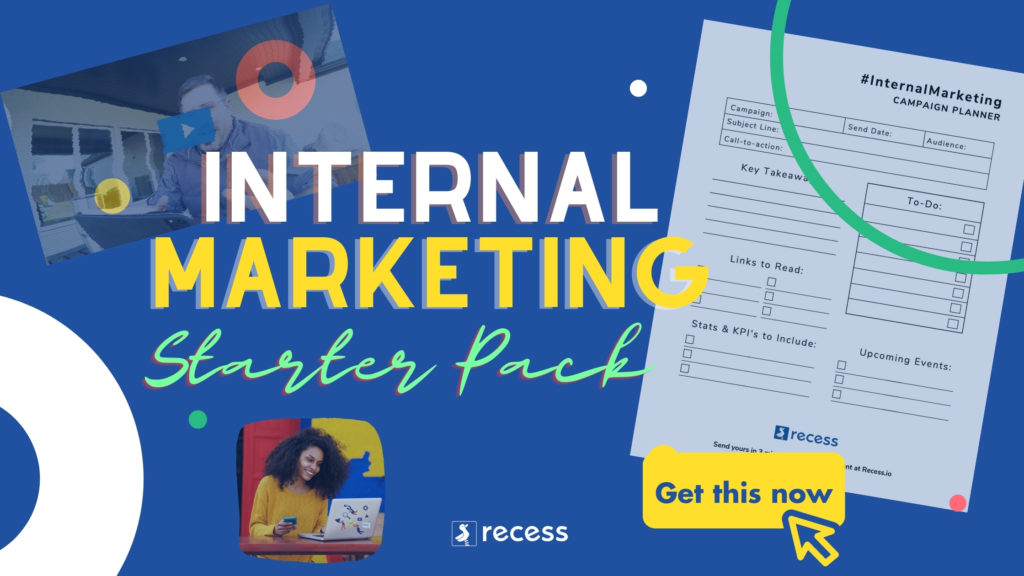Internal communication isn’t something business owners generally think about when they first come up with their business idea. They see a pain point they want to help people with and they build a team to solve the problem for customers.
You’ll see plenty of inspirational quotes around having a great business that solves a customer’s problem.
You don’t see a lot of quotes about how important internal communication is for a team.
It’s an overlooked part of building a business and because of that—business owners tend to hit walls.
- They don’t meet their monthly goals
- They don’t realize a team member is unhappy until they put their two weeks notice in
- They can’t take an idea and get traction because team members don’t know how to collaborate to bring it to life
If you’re having trouble with internal communication, or you’re a savvy business owner looking to avoid these problems, here are 10 ways to improve internal communication.
(Download this infographic for free HERE!)
#1: Create a schedule for internal broadcast emails
Just like the broadcast emails you’re sending to your email list—you’re going to send a different version to your employee email list. Your employees need to know what’s going on in your business and they’re not mind readers. If you’re not telling them what happened in a big meeting, they’re never going to know.
Give your employees a weekly, monthly, quarterly, and annual round up so they’re in the loop. For example, scheduling an employee internal newsletter to go live every Friday at 12pm (written by the CEO) with Recess.
#2: Use data/evidence to prove why what you’re doing is important
When you’re telling your team about a new idea (whether it’s a product, offer, campaign, new position to hire for, etc.), don’t tell them why you feel like it’s a good idea. Show them the hard facts that PROVE it’s a good idea.
Just like your customers, your employees are going to buy what you can prove—not what you kind of think is a good idea. For example, you can show them why you should be posting to Instagram 2x a day by showcasing a competitor who is getting great engagement posting that often. Or, you can show them how much better a marketing team performed after taking a coaching program so they know why it’s important for them to take the program seriously.
#3: Use metrics to show success or failure of initiatives
Employees can understand that you were able to grow product sales by 25% through your latest email campaign, that you’re averaging 1,500 new social media followers per week, or that customer support tickets were down by 10% last month when you make it that clear.
Using metrics to showcase the success (or failures) of new offers, products, campaigns, strategies, etc. improves internal communication by giving employees a chance to see what worked and what didn’t work.
#4: Don’t write like you’re authoring a textbook
When you send your internal email newsletter or any other communication to employees, you don’t want to have long paragraphs and little separation between text. Nobody wants to read that…nobody.
Make sure that you’re breaking up your paragraphs consistently (you can take this article as an example) and using headings and bullets to turn long content into chunks (again, notice the headers in this article). Make your internal emails reader friendly using Recess.
#5: Summarize all events or necessary meetings to all employees
Understandably, not every employee can make it to every event. Off-site events, conferences, coaching programs, and even important meetings aren’t always going to feature your entire team. When that’s the case, you want to bring everybody back into the loop.
Summarize what happened at the off-site events, what a team learned at a conference, how the coaching program taught a new way of productivity, and what changes or goals to expect after a specific meeting (ex. a meeting with only executives that no other employee took part in)
#6: Use action items to make sure meeting discussions turn into action
After your meetings, each employee should have a list of action items they need to complete to fulfill the goals of the meeting. This improves internal communication by ensuring that every employee understands what they need to do after the meeting.
Employees that know exactly what they need to get done post-meeting are going to be able to make it happen. Being crystal clear on what is needed from them is going to ensure it gets done and you’re able to take meeting ideas and turn them into action.
#7: Use marketing material to get points across (infographics, videos, etc.)
You read that right—start using your marketing materials for your employee newsletter or other internal communication touch points. For example, at your monthly all hands meeting you can bring an infographic of how well you hit your goals in those 30 days.
You can use videos to send updates to employees about the current status of a project, a feature in a big publication that you want them to know about, or to let them know that there’s going to be a minor delay in a project they’re currently working on. Don’t be afraid to use marketing materials to get your point across to employees easily.
#8: Make goals & KPIs available to everyone
Your goals shouldn’t be a secret. Improving internal communication means that everybody knows what they’re working towards. What are the sales goals the team is aiming for this quarter? What is considered a successful month for the social media team? How much revenue is an email campaign expected to bring in?
If your goals and KPI’s aren’t readily available for your employees to look at and understand, how are they going to be able to help you reach them? These aren’t just your goals—they’re their goals too.
#9: Send weekly or monthly updates to investors
Board meetings aren’t happening on a regular basis. By the time the next board meeting comes around, a lot has happened and you’re going to spend most of the time catching your investors up on what’s going on instead of getting their insight on what to do about it.
Instead of starting from scratch during each board meeting, send a weekly or monthly update to investors so they’re well aware of what’s happening. Then, when it’s time to meet you can quickly summarize everything happening and get into the good stuff—their advice on how you can improve.
#10: Ask employees how they would want to see communication improved
And of course, you want to ask your employees where they see problems in your current internal communication and how they would want to see them resolved. Your employees are going to know if they’re always out of the loop about new partnerships and products and they can tell you what they need to fix it.
Chances are they need an internal newsletter that gives them updates on things happening in the organization that don’t require their input—but do require their output.
Great internal communication doesn’t happen by accident. It happens on purpose, when a team can get updates from their CEO, read about what’s going on in a reader-friendly newsletter, and get advice from their trusted board of investors without bogging them down with updates.







